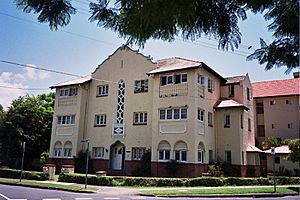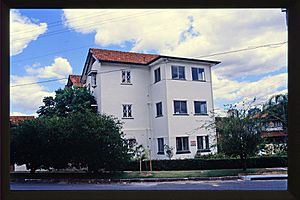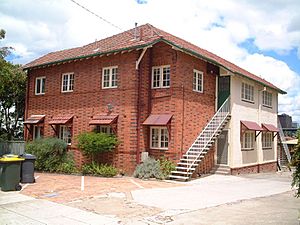Julius Street Flats facts for kids
Quick facts for kids Julius Street Flats |
|
|---|---|
| Lua error in Module:Location_map at line 420: attempt to index field 'wikibase' (a nil value). | |
| Location | 15 Julius Street, New Farm, City of Brisbane, Queensland, Australia |
| Design period | 1919 - 1930s (interwar period) |
| Built | 1934 - early 1950s |
| Official name: Julius Street Flats New Farm, Ardrossan, Green Gables, Julius Lodge | |
| Type | state heritage (built, landscape) |
| Designated | 4 August 1997 |
| Reference no. | 601895 |
| Significant period | 1930s-1950s early (fabric) 1930s (historical) |
| Significant components | terracing, views from, residential accommodation - flat/s, views to, furniture/fittings, driveway, lead light/s, laundry / wash house, pathway/walkway, trees/plantings, fence/wall - perimeter, boat shed, garden/grounds, road/roadway, garage, basement / sub-floor, residential accommodation - caretaker's quarters |
The Julius Street Flats are a group of seven special apartment buildings in New Farm, Brisbane, Australia. They are important because of their history and unique design. These buildings were mostly constructed between 1934 and 1938. The seven apartment blocks are called Ardrossan, Green Gables, Julius Lodge, Syncarpia, Ainslie, Pine Lodge, and Evelyn Court. They are listed on the Queensland Heritage Register, which means they are protected for their historical value.
A Look Back: History of the Flats
The land where the Julius Street Flats stand has a long history. It was once part of a large property owned by early settlers. Later, in the 1920s, a man named Julius Rosenfeld ran a sawmill on this very spot.
From Sawmill to Homes
In 1931, a big fire destroyed Rosenfeld's sawmill. After the fire, in 1933, Julius Rosenfeld decided to divide the land into smaller blocks. He created a short street, which was named Julius Street after him. This street was officially opened in 1934. Soon after, the seven apartment buildings were constructed on these new blocks between 1934 and 1938.
Why Flats Became Popular
In the 1920s and 1930s, Brisbane needed more homes. Many people were moving to the city, and there weren't enough houses. This led to a boom in "flats" or apartment buildings. It was a new way of living for many people.
There were different types of flats built. Some were for families, some were more luxurious, and some were smaller "bachelor" flats for single people. These new buildings often had modern features like built-in kitchens and hot water. They were usually two or three stories high.
Flats became popular for several reasons. They were often cheaper to rent than houses. Also, families were becoming smaller, so less space was needed. Many flats were built near tram lines, making it easy to get to work or shops.
The Brisbane City Council (BCC) had rules for building flats. These rules helped control how big the buildings could be and how much land they could cover. This is why most flats in Brisbane from this time are not very tall.
Stories of Each Building
Ardrossan
Ardrossan was designed by famous Brisbane architects Chambers and Ford in 1934. It's a beautiful three-story building with a Spanish Mission style. It has six flats, each with two bedrooms. During World War II, the residents even built an air raid shelter in the grounds behind Ardrossan for safety.
Green Gables
Green Gables was built around 1935. It's a three-story building with an Old English style. It originally had a mix of brick and timber, but later, stucco was added to make it look like a full masonry building. Each of its six flats had two bedrooms and a "smoker's balcony." Over time, these balconies were enclosed.
Julius Lodge (formerly Nanmara)
Julius Lodge was built in 1934. It was originally called Nanmara. This two-story building had eight flats, each with one bedroom. Later, a second bedroom was added to each flat. The outside of the building was also changed with stucco.
Syncarpia
Syncarpia was built in 1934 by architects Addison and Macdonald. It's a two-story timber building with an Old English style. Its name, Syncarpia, comes from a type of timber, possibly linking back to the site's sawmill past. When it was first built, it had seven flats and was rented only to males. Later, it became a boarding house for single women.
Ainslie
Ainslie was built between 1934 and 1935. It's a two-story brick building with an Old English style. It contains four two-bedroom flats. The owners, Fred and Ethel Havill, were also involved in building other flats in New Farm.
Pine Lodge (formerly Aloha Court)
Pine Lodge, originally called Aloha Court, was built in 1935. It's a two-story concrete building with an Old English style. It has four two-bedroom flats and overlooks the Brisbane River. Below the building, you can still see the remains of old lime kilns from the area's industrial past. The builder, Ernest William Mazlin, had a family history in timber and mining in Queensland.
Evelyn Court
Evelyn Court was built between 1937 and 1938. It's a three-story concrete building with an Art Deco style, which was quite modern for its time. It has six two-bedroom flats and also overlooks the Brisbane River. The building was originally planned with a hipped roof like Pine Lodge, but its design was changed to a flat roof during construction. The name "Evelyn" is special to the builder, Ernest William Mazlin, as it was his family's property name.
Julius Street Today
Julius Street is a short, quiet street. It's special because it's surrounded by these well-preserved 1930s apartment buildings. The local community sees it as a unique and important place.
What the Flats Look Like
The Julius Street Flats are a great example of apartment buildings from the 1930s. They show different popular architectural styles of that time.
Ardrossan
Ardrossan is a three-story building with a Spanish Mission style. It has a tiled roof and brickwork on the ground floor. The front has a central entrance with a decorative arch and a special window above it. Each flat has two bedrooms and an enclosed front sleep-out (a type of verandah).
Green Gables
Green Gables is a three-story building with an Old English style. It has a tiled roof and a mix of masonry and fibrous cement on its outside. The front has a central entrance and projecting sections with diamond-shaped windows. Each flat has two bedrooms, an enclosed sleep-out, and an enclosed "smoker's balcony."
Syncarpia
Syncarpia is a two-story building with an Old English style. It has a tiled roof and imitation half-timbering on its exterior. The front has a central verandah. It now has five self-contained flats, ranging from one to three bedrooms.
Ainslie
Ainslie is a two-story brick building with an Old English style. It has a tiled roof and patterned brickwork. The front has a central verandah with timber posts. It contains four two-bedroom flats, each with an enclosed front sleep-out and rear verandah.
Pine Lodge
Pine Lodge is a two-story concrete building with a tiled roof and an Old English style. It has bay windows and overlooks the Brisbane River. It contains four two-bedroom flats. The central staircase is made of concrete with shiny terrazzo steps.
Evelyn Court
Evelyn Court is a three-story concrete building with a flat roof and an Art Deco style. It has strong vertical lines and stepped parapets (parts of the wall that extend above the roof). It has six two-bedroom flats and also overlooks the Brisbane River. The building has a central staircase and some original black and white bathroom tiles.
Why They Are Heritage Listed
The Julius Street Flats are listed on the Queensland Heritage Register for several important reasons:
- Showing History: They show how Brisbane grew and how people lived in the 1930s, especially with the rise of apartment living due to a housing shortage. They also remind us of the area's past as a sawmill site.
- Rare Examples: This group of well-preserved 1930s apartment buildings is quite rare in Brisbane. Rules changed after 1937, making this type of development less common.
- Typical Features: The flats show the main types of apartment buildings built in Brisbane during that time, from smaller units to more fancy ones. They also display popular architectural styles like Old English, Spanish Mission, and Art Deco. Ardrossan is a great example of work by famous architects Chambers and Ford.
- Beautiful Design: The flats together create a unique and attractive look for Julius Street. Their size, shape, materials, and details make them an important part of the New Farm area and add to the beauty of the Brisbane Riverfront.
- Community Connection: The flats have a strong link to the local community, which values their history and unique character.
- Special People: The site's history, from sawmill to flats, is connected to Julius Rosenfeld and Ernest Mazlin, who were important in Queensland's timber industry.
|




